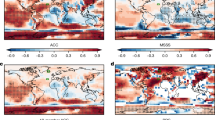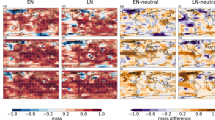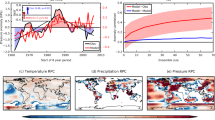Abstract
Advances in seasonal forecasting have brought widespread socio-economic benefits. However, seasonal forecast skill in the extratropics is relatively modest1, prompting the seasonal forecasting community to search for additional sources of predictability2,3. For over a decade it has been suggested that knowledge of the state of the stratosphere can act as a source of enhanced seasonal predictability; long-lived circulation anomalies in the lower stratosphere that follow stratospheric sudden warmings are associated with circulation anomalies in the troposphere that can last up to two months4,5. Here, we show by performing retrospective ensemble model forecasts that such enhanced predictability can be realized in a dynamical seasonal forecast system with a good representation of the stratosphere. When initialized at the onset date of stratospheric sudden warmings, the model forecasts faithfully reproduce the observed mean tropospheric conditions in the months following the stratospheric sudden warmings. Compared with an equivalent set of forecasts that are not initialized during stratospheric sudden warmings, we document enhanced forecast skill for atmospheric circulation patterns, surface temperatures over northern Russia and eastern Canada and North Atlantic precipitation. We suggest that seasonal forecast systems initialized during stratospheric sudden warmings are likely to yield significantly greater forecast skill in some regions.
This is a preview of subscription content, access via your institution
Access options
Subscribe to this journal
Receive 12 print issues and online access
$259.00 per year
only $21.58 per issue
Buy this article
- Purchase on Springer Link
- Instant access to full article PDF
Prices may be subject to local taxes which are calculated during checkout




Similar content being viewed by others
References
Oldenborgh, G. J., van, Balmaseda, M., Ferranti, L., Stockdale, T. N. & Anderson, D. L. T. Evaluation of atmospheric fields from the ECMWF seasonal forecasts over a 15-year period. J. Clim. 18, 3250–3269 (2005).
Kirtman, B. & Pirani, A. WCRP position paper on seasonal prediction. WCRP Informal Report, Vol. 3 (WCRP, 2008).
NRC Assessment of Intraseasonal to Interannual Climate Prediction and Predictability (National Academies Press, 2010).
Baldwin, M. P. & Dunkerton, T. J. Stratospheric harbingers of anomalous weather regimes. Science 294, 581–584 (2001).
Thompson, D. W. J., Baldwin, M. P. & Wallace, J. M. Stratospheric connection to Northern Hemisphere wintertime weather: Implications for prediction. J. Clim. 15, 1421–1428 (2002).
Gerber, E. P., Orbe, C. & Polvani, L. M. Stratospheric influence on the tropospheric circulation revealed by idealized ensemble forecasts. Geophys. Res. Lett. 36, L24801 (2009).
Marshall, A. G. & Scaife, A. A. Improved predictability of stratospheric sudden warming events in an atmospheric general circulation model with enhanced stratospheric resolution. J. Geophys. Res. 115, D16114 (2010).
Baldwin, M. P. et al. Stratospheric memory and skill of extended-range weather forecasts. Science 301, 636–640 (2003).
Charlton, A. J., O’Neill, A., Stephenson, D. B., Lahoz, W. A. & Baldwin, M. P. Can knowledge of the state of the stratosphere be used to improve statistical forecasts of the troposphere? Q. J. R. Meteorol. Soc. 129, 3205–3224 (2003).
Christiansen, B. Downward propagation and statistical forecast of the near-surface weather. J. Geophys. Res. 110, D14104 (2005).
Siegmund, P. Stratospheric polar cap mean height and temperature as extended-range weather predictors. Mon. Weather Rev. 133, 2436–2448 (2005).
Maycock, A. C., Keeley, S. P. E., Charlton-Perez, A. J. & Doblas-Reyes, F. J. Stratospheric circulation in seasonal forecasting models: Implications for seasonal prediction. Clim. Dynam. 36, 309–321 (2011).
Mukougawa, H., Hirooka, T. & Kuroda, Y. Influence of stratospheric circulation on the predictability of the tropospheric Northern Annular Mode. Geophys. Res. Lett. 36, L08814 (2009).
Scinocca, J. F., McFarlane, N. A., Lazare, M., Li, J. & Plummer, D. Technical note: The CCCma third generation AGCM and its extension into the middle atmosphere. Atmos. Chem. Phys. 8, 7055–7074 (2008).
Thompson, D. W. & Wallace, J. M. Regional climate impacts of the Northern Hemisphere annular mode. Science 293, 85–89 (2001).
Hardiman, S. C., Butchart, N., Hinton, T. J., Osprey, S. M. & Gray, L. J. The effect of a well resolved stratosphere on surface climate: Differences between CMIP5 simulations with high and low top versions of the Met Office climate model. J. Clim. 25, 7083–7099 (2012).
Roff, G., Thompson, D. W. J. & Hendon, H. Does increasing model stratospheric resolution improve extended-range forecast skill? Geophys. Res. Lett. 38, L05809 (2011).
Uppala, S. M. et al. The ERA-40 re-analysis. Q. J. R. Meteorol. Soc. 131, 2961–3012 (2005).
Dee, D. P. et al. The ERA-Interim reanalysis: Configuration and performance of the data assimilation system. Q. J. R. Meteorol. Soc. 137, 553–597 (2011).
Baldwin, M. P. & Thompson, D. W. J. A critical comparison of stratosphere–troposphere coupling indices. Q. J. R. Meteorol. Soc. 135, 1661–1672 (2009).
Rayner, N. A. et al. Global analyses of sea surface temperature, sea ice, and night marine air temperature since the late nineteenth century. J. Geophys. Res. 108, 4407 (2003).
Acknowledgements
M.S. gratefully acknowledges funding by Environment Canada through a Grants and Contributions Agreement with the University of Toronto. We thank B. Merryfield, J. Fyfe and N. Gillett for their helpful comments.
Author information
Authors and Affiliations
Contributions
M.S., J.F.S. and V.V.K. designed the experiments. All authors interpreted the results and contributed to writing the paper.
Corresponding author
Ethics declarations
Competing interests
The authors declare no competing financial interests.
Supplementary information
Supplementary Information
Supplementary Information (PDF 290 kb)
Rights and permissions
About this article
Cite this article
Sigmond, M., Scinocca, J., Kharin, V. et al. Enhanced seasonal forecast skill following stratospheric sudden warmings. Nature Geosci 6, 98–102 (2013). https://doi.org/10.1038/ngeo1698
Received:
Accepted:
Published:
Issue Date:
DOI: https://doi.org/10.1038/ngeo1698
This article is cited by
-
Extreme stratospheric wave activity as harbingers of cold events over North America
Communications Earth & Environment (2023)
-
Windows of opportunity for predicting seasonal climate extremes highlighted by the Pakistan floods of 2022
Nature Communications (2023)
-
Role of Stratospheric Processes in Climate Change: Advances and Challenges
Advances in Atmospheric Sciences (2023)
-
Northern winter stratospheric polar vortex regimes and their possible influence on the extratropical troposphere
Climate Dynamics (2023)
-
Boreal winter stratospheric climatology in EC-EARTH: CMIP6 version
Climate Dynamics (2023)



